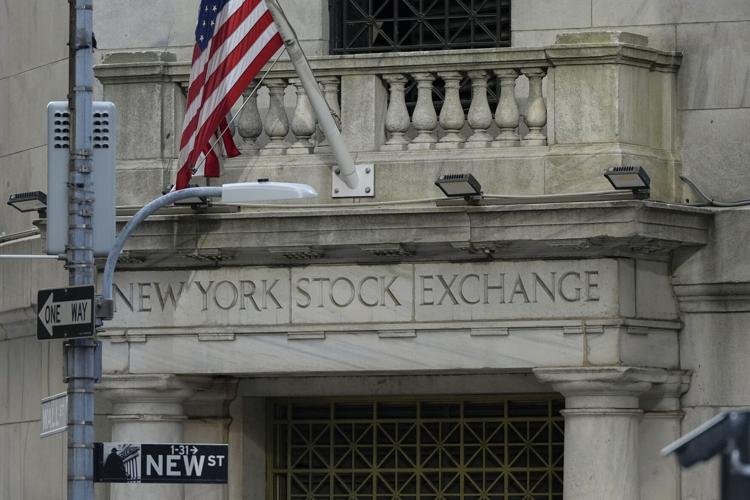
Unpacking Trump’s Latest Moves: A Tidal Wave for Wall Street
Trump’s latest trade policies have sent shockwaves through Wall Street, triggering investor anxiety, market volatility, and uncertainty about the U.S. economy’s future stability. Experts urge long-term strategies and diversification to weather the storm.
The implications of Trump’s recent actions on Wall Street, analyzing how his strategies might lead to economic turmoil. We will look at past policies, current investor reactions, and potential future consequences.
Imagine waking up to find your investments at risk because of a tweet from the President. This is the reality many investors are currently facing as Trump’s unpredictable trade strategies unfold. While the previous trade war caused significant concern, the latest developments point to an even more troubling future for Wall Street and the economy.
The Chaotic Landscape of Trump’s Trade Policy
Overview of Trump’s Trade War History
Donald Trump’s trade policies have been nothing short of tumultuous. Since he took office in January 2017, he has engaged in a series of trade wars that have reshaped the landscape of international commerce. The primary aim? To protect American jobs and industries. But at what cost?
Initially, Trump targeted China, accusing it of unfair trade practices. He imposed tariffs on billions of dollars worth of Chinese goods. This move was intended to level the playing field for American manufacturers. However, it also sparked retaliatory tariffs from China, leading to a back-and-forth that left many industries reeling.
As the trade war escalated, it became clear that the impacts were widespread. Farmers, manufacturers, and consumers all felt the pinch. The uncertainty surrounding these policies created a ripple effect, causing businesses to hesitate in their investment decisions. Was this really the best approach to securing American interests?
Key Actions Taken Recently
In recent months, Trump has continued to shake things up. His administration has introduced new tariffs and trade restrictions, particularly targeting countries like Canada and Mexico. These actions have raised eyebrows and concerns among economists and investors alike.
- Tariffs on Steel and Aluminum: Trump reinstated tariffs on steel and aluminum imports, arguing that it was necessary for national security.
- Trade Agreements: He has also sought to renegotiate existing trade agreements, including NAFTA, which was replaced by the USMCA.
- China Phase One Deal: The much-publicized Phase One trade deal with China was signed, but many experts question its effectiveness.
These actions have led to a chaotic environment. Investors are left guessing what the next move will be. As one financial analyst put it,
“Trump’s policies have been a rollercoaster for investors, causing jitters across the market.”
Comparative Analysis with Previous Policies
When comparing Trump’s trade policies to those of previous administrations, the differences are stark. Previous leaders often favored diplomacy and multilateral agreements. Trump, on the other hand, has taken a more aggressive, unilateral approach.
For instance, while past administrations worked to build alliances through trade agreements, Trump has often opted for confrontation. This has led to strained relationships with traditional allies. The question remains: Is this approach sustainable in the long run?
Economists have weighed in on the effectiveness of these policies. Some argue that the tariffs have protected certain industries, while others point out that they have led to increased prices for consumers. The debate continues, but one thing is clear: the ramifications of these policies extend beyond American borders.
Potential Ramifications on Global Trade Relations
The implications of Trump’s trade policies are profound. They have not only affected the U.S. economy but have also shaken global trade relations. Countries around the world are reevaluating their strategies in response to the unpredictability of U.S. trade policy.
As nations adjust to the new landscape, the potential for conflict increases. Trade wars can escalate quickly, leading to economic downturns. The interconnectedness of the global economy means that decisions made in Washington can have far-reaching consequences.
Trump’s trade policies have created a chaotic environment that is difficult to navigate. The historical context, recent actions, and comparative analysis with previous policies all paint a picture of uncertainty. As the world watches, the future of global trade hangs in the balance.
Investor Reactions: Anxiety in the Financial Markets
The financial markets are in a state of flux. Investors are feeling the pressure. Recent announcements from former President Trump have sent ripples through Wall Street. The reactions from key investors and financial analysts reveal a landscape filled with uncertainty.
Responses from Key Investors and Financial Analysts
Many prominent investors have voiced their concerns. They are not just worried about the immediate effects of policy changes but also about the long-term implications. For instance, one market analyst stated,
“Investor sentiment has never been more volatile due to unpredictable policy shifts.”
This sentiment resonates with many in the financial community.
Investors are grappling with a barrage of information. Each announcement seems to bring new challenges. Some investors are adopting a wait-and-see approach. Others are making swift moves to protect their portfolios. This divide highlights the anxiety permeating the market.
Market Fluctuations Following Trump’s Announcements
Market fluctuations have been dramatic. Following Trump’s latest announcements, stocks have seen significant swings. One day, the market may surge; the next, it could plummet. This volatility is unsettling for many.
- Stock Market Reactions: Major indices have experienced sharp declines. Investors are reacting to news with heightened sensitivity.
- Sector-Specific Impacts: Certain sectors are feeling the brunt more than others. For example, technology and manufacturing stocks have been particularly volatile.
- Investor Strategies: Some investors are shifting their strategies. They are moving towards safer assets, like bonds or gold, to hedge against uncertainty.
These fluctuations raise questions. How can investors navigate such a turbulent environment? What strategies can they employ to safeguard their investments?
Case Studies of Impacted Sectors
To understand the broader implications, it’s essential to look at specific sectors. The technology sector, for instance, has been a focal point. With trade tensions escalating, tech companies that rely on international supply chains are particularly vulnerable.
Consider the case of a major tech firm. After a negative announcement from Trump regarding tariffs, their stock price dropped significantly. Investors reacted swiftly, fearing increased costs and reduced profits. This scenario is not unique. Many companies are facing similar challenges.
Another sector feeling the heat is manufacturing. Companies that depend on exports are anxious. They worry about potential tariffs and trade barriers. This anxiety is reflected in their stock prices, which have fluctuated wildly in response to news.
Anecdotal Investor Experiences
Anecdotal evidence from investors paints a vivid picture. One investor shared their experience of watching their portfolio lose value overnight. They described the feeling as “gut-wrenching.” This sentiment is echoed by many who are feeling the strain of market volatility.
Another investor mentioned how they have started to diversify their investments. They are looking beyond traditional stocks and exploring alternative assets. This shift is a direct response to the unpredictable nature of the current market.
Exploring Market Sentiment Surveys
Market sentiment surveys provide valuable insights. They reveal how investors are feeling about the current climate. Many surveys indicate a growing sense of fear and uncertainty. Investors are worried about the future. They are concerned about how policy changes will affect their investments.
These surveys often show a stark contrast between bullish and bearish sentiments. While some investors remain optimistic, many are bracing for potential downturns. This divide highlights the complexity of the current market environment.
Highlighting Specific Sectors Most Affected
As mentioned earlier, certain sectors are more affected than others. The technology and manufacturing sectors are at the forefront. However, the energy sector is also experiencing turbulence. Fluctuating oil prices and regulatory changes are causing anxiety among investors.
Investors are closely monitoring these sectors. They are looking for signs of stability or further decline. The stakes are high, and the pressure is mounting.
In summary, the reactions from investors and analysts reflect a broader sense of anxiety in the financial markets. The unpredictable nature of policy shifts is causing significant fluctuations. As investors adapt their strategies, the landscape continues to evolve. Understanding these dynamics is crucial for anyone navigating today’s financial environment.
Looking Forward: Economic Predictions and Strategies
The economic landscape is constantly shifting. With the influence of political decisions, particularly those made by former President Trump, Wall Street faces a future filled with uncertainty. Investors are left wondering: what lies ahead? This section explores potential scenarios for Wall Street’s future, offers advice from economic experts, and discusses how investors can prepare for volatility.
Potential Scenarios for Wall Street’s Future
Wall Street is known for its unpredictability. As we look ahead, several scenarios could unfold:
- Continued Volatility: The market may experience ongoing fluctuations. This could be driven by political tensions, trade wars, or unexpected economic data.
- Stabilization: Alternatively, the market might stabilize if economic indicators improve. A strong job market or rising consumer confidence could lead to a more predictable environment.
- Recession: There’s always the risk of a recession. If economic policies fail to stimulate growth, Wall Street could face a downturn.
Each of these scenarios presents unique challenges and opportunities for investors. The key is to stay informed and adaptable.
Advice from Economic Experts
Economic experts have valuable insights to share. They emphasize the importance of understanding market trends and being prepared for change. Here are some key pieces of advice:
- Stay Informed: Knowledge is power. Investors should keep an eye on economic indicators, such as inflation rates and employment figures.
- Diversify Investments: As one expert noted,”In times of uncertainty, diversification becomes more crucial than ever.” – Economic StrategistBy spreading investments across various sectors, investors can mitigate risks.
- Consider Long-Term Strategies: Short-term gains can be tempting, but experts recommend focusing on long-term growth. This approach can help weather market storms.
Listening to expert advice can provide a roadmap for navigating the complexities of the market.
How Investors Can Prepare for Volatility
Volatility is a part of investing. However, there are strategies investors can employ to prepare:
- Build an Emergency Fund: Having cash reserves can provide a safety net during turbulent times.
- Review Investment Portfolios: Regularly assessing portfolios ensures that investments align with current market conditions and personal financial goals.
- Stay Calm: Emotional decision-making can lead to poor choices. Investors should remain level-headed and stick to their strategies.
By taking proactive steps, investors can better navigate the uncertainties that lie ahead.
As Wall Street faces an uncertain future shaped by political decisions and economic trends, investors must remain vigilant. Understanding potential scenarios, heeding expert advice, and preparing for volatility are essential strategies. The road ahead may be rocky, but with careful planning and a diversified approach, investors can position themselves for success. The key is to stay informed and adaptable in a world where change is the only constant.
TL;DR: Trump’s latest economic strategies create uncertainty for Wall Street, reminiscent of previous trade wars, raising questions about future market stability.
InvestorAnxiety, EconomicStrategies, USEconomy, FinancialMarketTurmoil, EconomicChaos, TrumpTradePolicies, WallStreetImpact, TrumpPresidencyRisks, TradeWarEffects
#WallStreetImpact, #InvestorAnxiety, #FinancialMarketTurmoil, #EconomicChaos, #TrumpTradePolicies, #TrumpPresidencyRisks, #TradeWarEffects, #EconomicStrategies, #USEconomy,#TrumpTrade, #WallStreet, #InvestorSentiment, #MarketVolatility, #EconomicUncertainty, #TradeWar, #StockMarket, #TariffImpact, #GlobalTrade, #FinancialAnalysis

